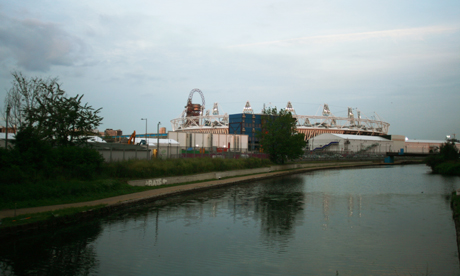The Olympics legacy – going for green

The Olympic Stadium at dusk. Photograph: Hackney Citizen
You can’t have failed to notice that normal life seemed to freeze in time for many while the eyes of the world watched the Olympics unfold on our doorstep last month.
The Games brought varying degrees of joy, criticism, pride, frustration, tears and smiles to many. Now will they also bring hope for a greener future?
The Olympics’ legacy is intended to live on long past the lives of the sporting event itself. The eyes of the UK will now turn to see if the controversial Games will indeed ‘inspire a generation’ of healthier, sportier children.
And here in Hackney, we’ll be asking if they’ll also leave the promised legacy of an East End revival through urban generation and sustainable development.
The London Legacy Development Corporation is the body responsible for ensuring the Olympics provide a sustainable legacy to the local area. It has published a sustainability guide presenting its vision of life in the Queen Elizabeth Park in 2030.
This aims to present a picture of how it will actually feel to step into the park: the guide proposes that you arrive by bike, stroll along canal paths, watch children kayaking and enjoy the bio-diverse wetlands of the River Lee.
Perhaps I‘m just lucky to do all of these things now, anyway … or is the vision sufficiently ambitious for effecting a cultural change?
There are many commendable aspects to the guide. These include independent shops, plans for new homes that exceed the Government’s 2016 Zero Carbon homes requirements with features such as green roofs and solar panels; rainwater harvesting and grey and black water recycling; ‘walkable’ neighbourhoods designed to favour pedestrians, cyclists and public transport; 45 hectares of biodiverse open space that will contribute to local biodiversity action plan targets; and delivery of low energy events with zero waste to landfill.
On the other hand, there’s much more to be done in order to realise the ambition of leading sustainability delivery. Some of the areas that need further thinking are how to re-use materials on-site and how a culture of sustainability within the local area will actually be achieved.
The guide explains, for example, that residents will be able to grow food in their gardens, balconies and in allotments– the difference will be made in the manner in which they facilitate and encourage this to happen.
The athletes’ village will become a new neighbourhood with close to 3,000 homes, a school for 1,800 children, shops, healthcare facilities and parks. Nearly 1,400 of these homes were bought by Triathlon Homes in 2009 to be part-sold or rented as affordable housing.
Yet the other 1,450 – alongside land to build a further 2,000 – were sold last year to the Qatari ruling family’s property company, who plan to rent the bulk of their share as private apartments. They paid £557m for the privilege, costing the UK taxpayer a whopping £275m and limiting the Park’s affordable housing to just 35% of its total.
So what are the next steps? Next month the Legacy Corporation will become the planning authority for the Park and surrounding area, thus bestowing on them the power to agree or refuse planning applications.
The LLDC’s Communities and Business Executive, Victoria Stonebridge, explained that they will aim to encourage independent shops, rather than chain supermarkets, to bid for space in the Park.
The legacy benefits are intended to stretch beyond the Park’s borders and the LLDC will be developing its Sustainable Lifestyles Programme in consultation with local groups.
Targets include developing an occupant engagement programme to reduce emissions by 15% over five years and all homes to include smart meters that collect energy consumption data. This level of monitoring is both welcomed and vital to make sure that a sustainable legacy can indeed live on.
